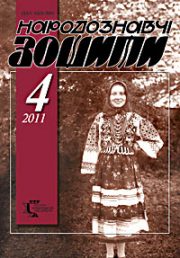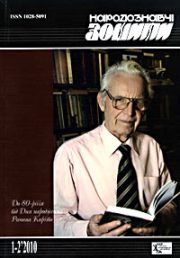The Ethnology Notebooks. 2019, № 6 (150), 1626—1639
UDK75.052 (477.86): 75.046.3: 75.071.1 – 055.1Сельський Р.
DOI https://doi.org/10.15407/nz2019.06.1626
KOROL Sofia
ORCID ID: https://orcid.org/0000-0001-6763-4938
Candidate of Art History (Ph. D.)
the Head of the Department of Art History
of the Ethnology Institute of the National
Academy of Sciences of Ukraine
15, Svobody Avenue, 79000, Lviv, Ukraine
e-mail: artso@ukr.net
Abstract. Introduction.Ukrainian ecclesiastical art of the first half of the 20th century has been not studied enough, and its heritage, undefeated in the soviet era, is a subject to new destruction, since there is no consolidated view of this art, no studies that reveal the level and significance of particular artistic achievements. Today, this art undergoes, at best, a chaotic “restoration”, when, upon the existing compositions, non-professional artists make “outlines” on top, thus “refreshing” the painting. In the worst case scenario, it simply collapses and disappears, as it happened this year in Slavsk.
The same uncertain is the fate of those churches that are out-of-use, and inside of which are stored works of monumental or easel ecclesiastical art.
Problem Statement.Roman Selskyi was a prominent Lviv painter who now is also known as a founder of the phenomenon that we today call the “Lvivschool of painting”. By this time, all researchers had studied only easel art of the artist, and his monumental sacred works had only brief references to literature. Nevertheless, in his biography there was a some period when he repeatedly carried out to sacred painting. Why it happened so, whether this painting was important, what were its formal features — the article tries to answer these questions.
Purpose. The study aims to show the non-coincidence of religious themes in the work of Roman Selskyi and to explore the peculiarities of the artistic style of polychromy in the church in Vyzhnyany, as it is the only surviving example of the monumental sacred painting of the artist.
Methods.This research has operated by methods of biographical, formal and contextual analyzes, that were applied to solve the formulated scientific problem.
Results.Despite almost all the religious works of R. Selskyi were lost, there was a period when the artist created a number of polychromy and easel works. They indicate that for one reason or another R. Selskyi worked for some time on the monumental decoration of church buildings, which in itself is worth the attention of researchers. The neglected church in Vyzhnyany, though to a some extent, makes it possible to reconstruct this heritage and see in which formal and stylistic directions the pursuits in the sphere of Ukrainian ecclesiastical art of the interwar period were conducted.
Conclusions.R. Selskyi gained experience in the field of monumental art and may have been on the path to developing his own line of religious art. The artistic criteria of his painting, not defined by the single term, were grouped around formal-coloristic problems, and in that direction, perhaps the artist would like to develop his religious art. The hole sacred heritage of the artist in the case of preservation, and even more so the long-term development, could become another formal and stylistic branch of such a completely unexplored artistic phenomenon as the Ukrainian religious art of the first half of the twentieth century.
Keywords: monumental paintings, sacred art, Roman-Catholic church in Vyzhnyany, Roman Selskyi, reconstruction, formal-stylistic analysis.
Received 19.11.2019
REFERENCES
Hrymaliuk, R. (2018). Monumental painting of the second half of the XIXth and early XXth centuries. Ecclesiastical art of Ukraine (Vol. 3, pp. 701—744). Kharkiv: Folio [in Ukrainian].
Herii, O., Turkevych-Klimashevskyi A., Kodlubai I., & Noha O. (2012). Ukrainian ecclesiastical art 1880—1920. (Western Region) (Vol. 1). Lviv: Ukrainski tehnologii [in Ukrainian].
Hakh, I. (2017). The era of Metropolitan: Ukrainian fine art of the first half of the XXth century. Lviv: Manuscript [in Ukrainian].
Wolaсska, J. (2012). «Towards the revival of religious art». The revival efforts for church art in Polish Lands between 1900—1939 (with particular emphasis on wall-paintings). Sacrum et Decorum (Vol. V, pp. 8—43) [in Polish].
Kryzhanivskyi, A. (2008). Osyp Kurylas: Album-monograph. Lviv: Zakhidnoukrainskyi informatsiino-vydavnychyi tsentr [in Ukrainian].
Kupchynska, L. (2009). The work of Theophil Kopystynskyi within the context of the development of the Fine arts in western Ukraine during the second half of the nineteenth and the beginning of the twentieth centuries. Lviv; Philadelphia [in Ukrainian].
Hakh, I., & Sydor, O. (Eds.). (2006). Yulian Butsmaniuk. The wall-painting of the Zhovkva, Church of the Holy Heart of Jesus. Lviv: Misioner [in Ukrainian].
Hrymaliuk, R., Hupalo, N., & Zhyshkovych, V. (2007). The Church of the St. Nicolas in Zolochiv. Lviv: Misioner [in Ukrainian].
Semchyshyn-Husner, O. (2009). The Church of the Assumption of Mary in Slavske Settlement, Skole Region, Lviv province: history of constraction and restoration. The Ethnology Notebook, 3—4 (87—88), 469—479 [in Ukrainian].
Studnytska, M., & Studnytskyi, R. (2016). Churches in Galicia of the end of ХІХth — the first half of the ХХth centuries. Lviv: LNAA [in Ukrainian].
Shymchuk, Y. (2006). Monumental paintings in the village of Vyzhnyany. Roman Selskyi (Pp. 260—261). Lviv: The Institute of the collecting of the Ukrainian art monuments at the SHSS. Kyiv: Oranta [in Ukrainian].
Melnyk, V., & Melnyk, I. (2016). Authorship, plots and technological features of the monumental paintings at the St. Nicholas church of Vyzhnyany. Christian sacred tradition: religion, spirituality, art (Pp. 272—275). Lviv [in Ukrainian].
Voloshyn, L. (2006). Roman Selskyi: worldview and formal aspects of creativity. Roman Selskyi. Graphics (Pp. 5—10). Lviv: The Institute of the collecting of the Ukrainian art monuments at the NTSH; Kyiv: Oranta [in Ukrainian].
Hrechko, I. (Ed.). Selskyi about Selskyi. (2004). In Roman Selskyi. Works from private collections (Pp. 22—29). Lviv: The Institute of the collecting of the Ukrainian art monuments at the NTSH. Kyiv: Oranta [in Ukrainian].
Shymchuk, Y. (2006). Roman Selskyi 1903—1990. Roman Selskyi (Pp. 5—18). Lviv: The Institute of the collecting of the Ukrainian art monuments at the NTSH. Kyiv: Oranta [in Ukrainian].
Voloshyn, L. (2006). The Ukrainian Artism of Roman Selskyi and its Occidental links. Roman Selskyi (Pp. 20—28). Lviv: The Institute of the collecting of the Ukrainian art monuments at the NTSH. Kyiv: Oranta [in Ukrainian].
Bartnicka-Gуrska, H. (1986). Kowarski Feliciian Shchensny: Sіownik Artystуw Polskich I obcych w Polsce dziaіaj (Vol. IV, pp. 207—212). Wroclaw; Warsaw; Krakow; Gdansk; Lodz [in Polish].
Yatsiv, R., & Hronska, H. (Ed.). (2018). Roman Turyn: under the European hat. In Roman Turyn (1900—1979): under the European hat (Pp. 5—42). Lviv [in Ukrainian].
Zvirynskyi, K., & Zvirynska-Chaban, Kh. (Ed.). (2017). Margit Selska. In All my painting is a prayer; Memories, interviews, reflections, articles (Pp. 186—194). Lviv: Manuscript-Lviv [in Ukrainian].
Gluzinska, A. (2003). The parish church of St. Nicholas in Vyzhnyany. Roman Catholic churches and monasteries of the former Ruthenian province (Vol. 11, pp. 317—340). Krakow: International Culture Center [in Polish].
Ostrowski, J.-K. (2000). The parish church of Exaltation of the Holy Cross in Jagiellonian Horodok. Roman Catholic churches and monasteries of the former Ruthenian province (Vol. VIII, pp. 81—98). Krakow: International Culture Center [in Polish].






